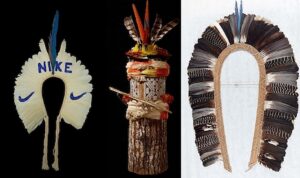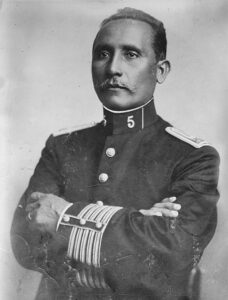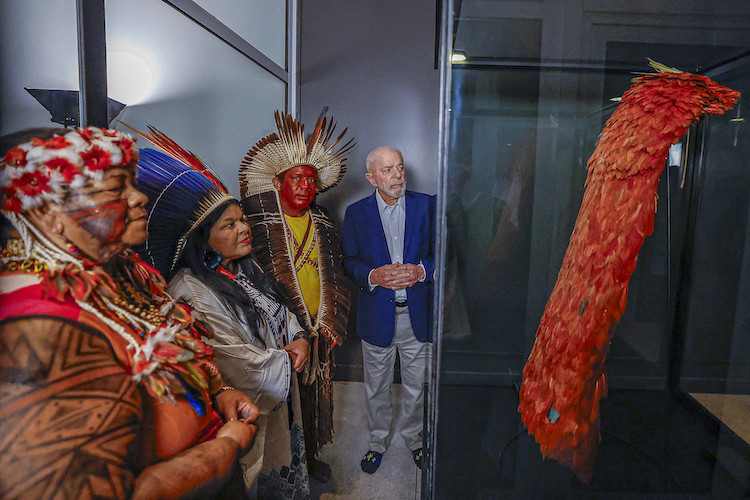BRAZIL – World News Bites
Reopening of Museu do Índio and Launch of Museu das Culturas Indígenas

A work by contemporary indigenous artist Denilson Baniwa, a Kuarup trunk and a Kayapo headdress, courtesy Museu Histórico Nacional, Rio de Janeiro, Brazil.
Two cultural institutions in Brazil, the Museu do Índio in Rio de Janeiro and the Museu das Culturas Indígenas in São Paulo, are set to play important roles in preserving and promoting indigenous cultures in the country. The Museu das Culturas Indígenas officially opened on June 30, 2024, in a seven-floor, 1,400-square-meter repurposed building. The museum’s inaugural exhibitions feature the works of artists Denilson Baniwa and Xadalu Tupã Jekupé, with a focus on themes such as displacement and colonialism. Outdoor murals on the museum premises reflect elements of Brazil’s Guaraní indigenous culture.
The Museu das Culturas Indígenas has engaged indigenous groups in the management and curation of its exhibitions and established committees of indigenous advisors who are responsible for providing context about the ancient and contemporary cultures of their respective tribes. The museum places a strong emphasis on oral storytelling and cultural exchange, with a rotating exhibition plan aimed at representing traditions from all 305 indigenous tribes in Brazil.

Marshal Cândido Mariano da Silva Rondon (5 May 1865 – 19 January 1958) was a Brazilian military officer most famous for his telegraph commission and exploration of Mato Grosso and the western Amazon basin, as well as his lifelong support for Indigenous Brazilians. Public domain.
The Museu do Índio, established in 1953 and financed by the Fundação Nacional do Índio (FUNAI), holds nearly 21,000 artifacts and documents. The Museu do Índio has been closed to the public since 2016 to address fire safety and electrical grid issues. Museum director Giovani Souza Filho assured the public that the closure was not due to a lack of funding, as the museum receives an annual budget of 12 million reais ($2.4 million). During the closure, indigenous groups were involved in curating and cataloguing artifacts and improved documentation.
The collection includes materials from the Rondon Commission, led by Cândido Mariano da Silva Rondon, that built telegraph lines across the Mata Grosso and remote areas of Brazil between 1900 to 1906. Rondon was a Brazilian military officer who documented, collected, and later fought publicly for recognition and respect for Brazilian tribal peoples.
The Museu do Índio is expected to reopen later in 2024, with a continued focus on transferring responsibilities for the preservation and dissemination of cultural heritage to Indigenous peoples.
Brazil Celebrates Return of the Tupinambá Sacred Cloak
As Brazil commemorates 200 years of independence, the country is placing renewed emphasis on its indigenous heritage. A major event in this cultural focus is the return of a sacred 16th-century Tupinambá cloak from the National Museum of Denmark to Brazil.
The cloak, made from approximately 4,000 scarlet guará feathers, measures around 120 cm by 80 cm and was historically worn by Tupinambá leaders. The cloak was taken to Europe by the Dutch in 1644 and later found its way to Denmark. It is one of only 11 known cloaks of its kind, all of which are currently held in European museums, in Italy, Switzerland, Belgium, and France.
The repatriation of the cloak is seen as a major step in establishing new protocols for the retrieval and management of sacred Indigenous artifacts both within Brazil and abroad. However, the cloak’s return has sparked a debate over where it should be held in perpetuity, in a national museum or in tribal hands.
The ceremonial return of the cloak was held at the National Museum in Rio de Janeiro and attended by Brazilian President Luiz Inácio Lula da Silva, Minister of Indigenous Peoples Sônia Guajajara, and more than 200 members of the

The Brazil Federal Public Defender’s Office (DPU) assists in the sale of products from Tupinambás farmers for the School Food Program. Photo: Gabriel Dell / DPU. CC0 1.0 Universal Public Domain Dedication.
community. During the event, Tupinambá representatives used the occasion to urge the government to address their land claims, chanting, “Mr. President, give us back our land.”
President Lula acknowledged the importance of the cloak, stating, “It is in the National Museum, but I hope everyone understands that its rightful place is not here.” Lula proposed that the National Museum should only serve as a temporary home for the cloak and that it should ultimately be displayed in Ilheus, Bahia, once an Indigenous cultural center is constructed.
The cloak is considered an ancestor by the Tupinambá, carrying a profound spiritual presence, and they assert that only Indigenous communities can provide the proper care for it due to its sacred nature. Despite calls for return by the indigenous creators of the cloak, the National Museum plans to feature the cloak as a highlight in its reopening exhibitions, scheduled for 2026. Museum officials maintain that the cloak was permanently donated to them by the National Museum of Denmark and they have not commented on plans to move it.
 President Lula and members of the Tupinambá community looking at the sacred cloak. Image coutesy office of the President, Government of Brazil.
President Lula and members of the Tupinambá community looking at the sacred cloak. Image coutesy office of the President, Government of Brazil. 

